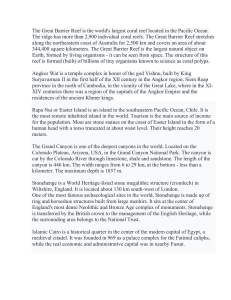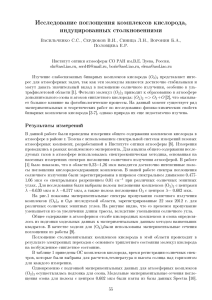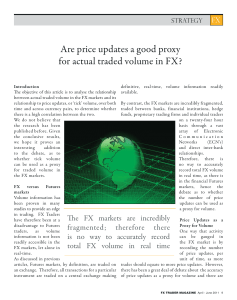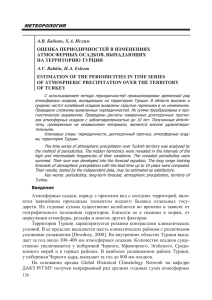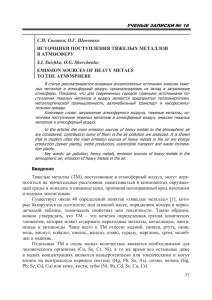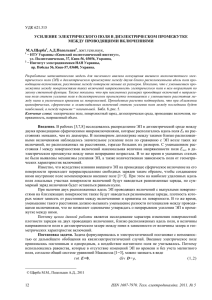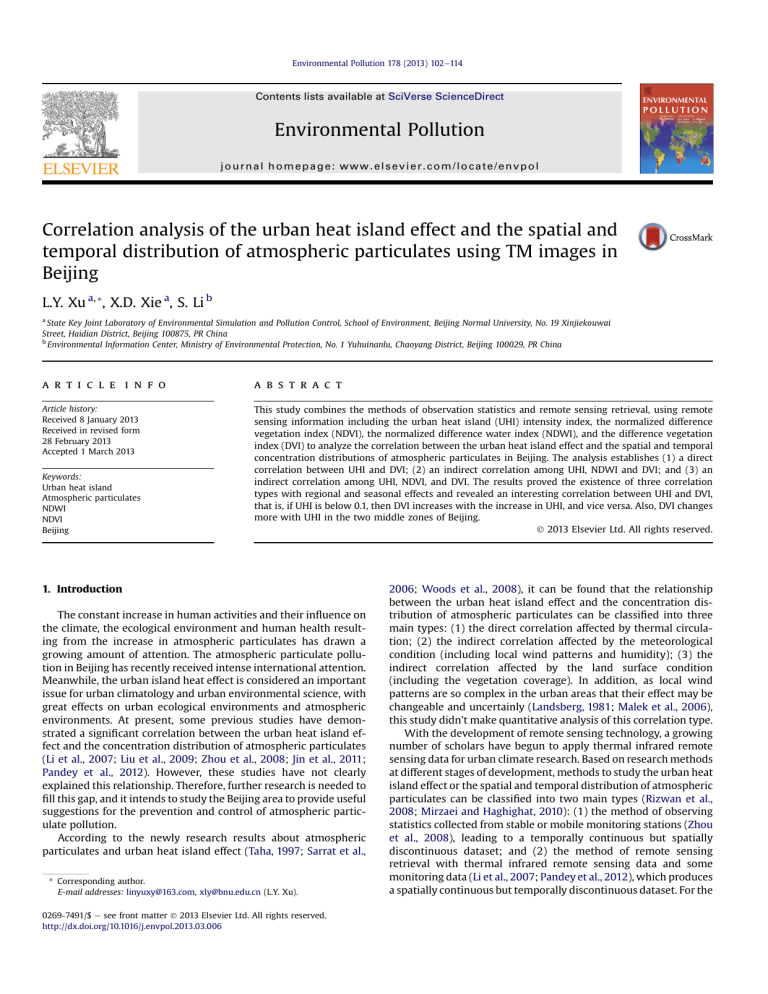
Environmental Pollution 178 (2013) 102e114 Contents lists available at SciVerse ScienceDirect Environmental Pollution journal homepage: www.elsevier.com/locate/envpol Correlation analysis of the urban heat island effect and the spatial and temporal distribution of atmospheric particulates using TM images in Beijing L.Y. Xu a, *, X.D. Xie a, S. Li b a State Key Joint Laboratory of Environmental Simulation and Pollution Control, School of Environment, Beijing Normal University, No. 19 Xinjiekouwai Street, Haidian District, Beijing 100875, PR China Environmental Information Center, Ministry of Environmental Protection, No. 1 Yuhuinanlu, Chaoyang District, Beijing 100029, PR China b a r t i c l e i n f o a b s t r a c t Article history: Received 8 January 2013 Received in revised form 28 February 2013 Accepted 1 March 2013 This study combines the methods of observation statistics and remote sensing retrieval, using remote sensing information including the urban heat island (UHI) intensity index, the normalized difference vegetation index (NDVI), the normalized difference water index (NDWI), and the difference vegetation index (DVI) to analyze the correlation between the urban heat island effect and the spatial and temporal concentration distributions of atmospheric particulates in Beijing. The analysis establishes (1) a direct correlation between UHI and DVI; (2) an indirect correlation among UHI, NDWI and DVI; and (3) an indirect correlation among UHI, NDVI, and DVI. The results proved the existence of three correlation types with regional and seasonal effects and revealed an interesting correlation between UHI and DVI, that is, if UHI is below 0.1, then DVI increases with the increase in UHI, and vice versa. Also, DVI changes more with UHI in the two middle zones of Beijing. Ó 2013 Elsevier Ltd. All rights reserved. Keywords: Urban heat island Atmospheric particulates NDWI NDVI Beijing 1. Introduction The constant increase in human activities and their influence on the climate, the ecological environment and human health resulting from the increase in atmospheric particulates has drawn a growing amount of attention. The atmospheric particulate pollution in Beijing has recently received intense international attention. Meanwhile, the urban island heat effect is considered an important issue for urban climatology and urban environmental science, with great effects on urban ecological environments and atmospheric environments. At present, some previous studies have demonstrated a significant correlation between the urban heat island effect and the concentration distribution of atmospheric particulates (Li et al., 2007; Liu et al., 2009; Zhou et al., 2008; Jin et al., 2011; Pandey et al., 2012). However, these studies have not clearly explained this relationship. Therefore, further research is needed to fill this gap, and it intends to study the Beijing area to provide useful suggestions for the prevention and control of atmospheric particulate pollution. According to the newly research results about atmospheric particulates and urban heat island effect (Taha, 1997; Sarrat et al., * Corresponding author. E-mail addresses: [email protected], [email protected] (L.Y. Xu). 0269-7491/$ e see front matter Ó 2013 Elsevier Ltd. All rights reserved. http://dx.doi.org/10.1016/j.envpol.2013.03.006 2006; Woods et al., 2008), it can be found that the relationship between the urban heat island effect and the concentration distribution of atmospheric particulates can be classified into three main types: (1) the direct correlation affected by thermal circulation; (2) the indirect correlation affected by the meteorological condition (including local wind patterns and humidity); (3) the indirect correlation affected by the land surface condition (including the vegetation coverage). In addition, as local wind patterns are so complex in the urban areas that their effect may be changeable and uncertainly (Landsberg, 1981; Malek et al., 2006), this study didn’t make quantitative analysis of this correlation type. With the development of remote sensing technology, a growing number of scholars have begun to apply thermal infrared remote sensing data for urban climate research. Based on research methods at different stages of development, methods to study the urban heat island effect or the spatial and temporal distribution of atmospheric particulates can be classified into two main types (Rizwan et al., 2008; Mirzaei and Haghighat, 2010): (1) the method of observing statistics collected from stable or mobile monitoring stations (Zhou et al., 2008), leading to a temporally continuous but spatially discontinuous dataset; and (2) the method of remote sensing retrieval with thermal infrared remote sensing data and some monitoring data (Li et al., 2007; Pandey et al., 2012), which produces a spatially continuous but temporally discontinuous dataset. For the L.Y. Xu et al. / Environmental Pollution 178 (2013) 102e114 method of observation statistics, the observation time, observation methods, environmental temperature, and even the air temperature at the position where the probe is installed could lead to uncertainty in the observation results and then influence the accuracy of the final results (Mirzaei and Haghighat, 2010). The accuracy of the remote sensing retrieval method is limited by the number of monitoring spots (Li et al., 2007; Rajasekar and Weng, 2009). Therefore, this study obtains TM images in different seasons of the same year and in the same season of different years to address the temporal discontinuity of the remote sensing retrieval method, and adopts remote sensing information to replace monitoring data to address the insufficient number of monitoring positions. Remote sensing information was obtained to reveal this relationship between urban heat islands and the concentration distribution of atmospheric particulates, including the urban heat island (UHI) 103 Table 1 Classification of the urban heat island intensity. Relative brightness temperature UHI intensity levels <0 0e0.1 0.1e0.2 0.2e0.4 >0.4 Green island Weak heat island Medium heat island Strong heat island Extremely strong heat island intensity index, NDVI (normalized difference vegetation index), NDWI (normalized difference water index) and DVI (difference vegetation index). Then, correlation analyses among the UHI intensity index, NDWI, NDVI, and DVI are used to establish a correlation model to further understand this relationship. Fig. 1. Distribution of the brightness temperature in Beijing on (a) March 14, 2009; (b) September 22, 2009; (c) May 30, 2008; (d) May 28, 2007. 104 L.Y. Xu et al. / Environmental Pollution 178 (2013) 102e114 Fig. 2. Distribution of the UHI intensity index in Beijing on (a) March 14, 2009; (b) September 22, 2009; (c) May 30, 2008; (d) May 28, 2007. 2. Methodology 2.1. Remote sensing data As it is difficult to obtain the clear TM images of all four seasons in one year, and there is the heating period in Beijing which affects the spatial and temporal distribution of atmospheric particulates seriously, this study divided the whole year into two seasons, that is, the non-heating season (from April to October) and the heating season (from November to March). TM images were obtained from the remote sensing data sharing website (http:// ids.ceode.ac.cn/) maintained by the earth observation and Digital Earth Science Center of the Chinese Academy of Sciences. In this study, TM images from May 28, 2007, May 30, 2008, and March 14 and September 22, 2009 were selected to represent the changes between different seasons of the same year and in the same season between different years. 2.2. Information extraction methods Recent research results have shown that the relationship between temperature and plant growth is much closer than that between precipitation and plant growth (Woods et al., 2008), and that the correlation between the surface temperature and NDVI is clearly negative in urban areas (Lo et al., 1997; Wilson et al., 2003). Meanwhile, vegetation has a purifying action with respect to atmospheric particulates. Similarly, the surface temperature has a significant negative relationship with NDWI as in the study in the Pearl River delta region (Chen et al., 2006). Meanwhile, after local wind patterns, the humidity is the main factor affecting the concentration distribution of atmospheric particulates (Chan et al., 1997). Therefore, NDVI and NDWI can be used to respectively indicate the effect of the vegetation coverage and the humidity on the indirect correlation between the urban heat island effect and the concentration distribution of atmospheric particulates. Also, the concentration of atmospheric particulates exhibits a significant negative relationship with DVI. Meanwhile, the spatial and temporal distribution of the inversion results and real observation data tend to be basically the same (Zhou et al., 2009; Tang et al., 2011). Therefore, the distribution of DVI can be used to indicate the concentration distribution of atmospheric particulates. According to the remote sensing retrieval, this study extracts remote sensing information, including UHI intensity index, NDWI, NDVI, and DVI, in different seasons of the same year and in the same season of different years. And then it divide the study area into 4 annular zones based on the degree of urban development, and then to analyze the spatial distribution of UHI intensity index, NDWI, NDVI, and DVI L.Y. Xu et al. / Environmental Pollution 178 (2013) 102e114 105 Fig. 3. Distribution of UHI intensity levels in Beijing on (a) March 14, 2009; (b) September 22, 2009; (c) May 30, 2008; (d) May 28, 2007. and make correlation analyses to reveal the relationship between the urban heat island effect and the concentration distribution of atmospheric particulates from three main aspects based on the above theoretical analysis, including (1) the direct correlation between the UHI intensity index and DVI; (2) the indirect correlation among the UHI intensity index, NDWI and DVI; (3) the indirect correlation among the UHI intensity index, NDVI, and DVI. Finally, a correlation model is established to further understand this relationship. In addition, the influence of atmospheric particulates from outside of the study area is considered under the assumption that all atmospheric particulates in the study area are distributed in the same way under the influence of the urban heat island effect. According to above analysis, the key step of this study is the extraction of remote sensing information, including the UHI intensity index, NDWI, NDVI, and DVI. These data have been obtained using appropriate methods. (1) UHI intensity index calculation The surface temperature and temperature patterns in urban areas are so different that infrared temperature cannot be used to replace the surface temperature (Eliasson, 1996). However, many studies have established a good correlation between these temperatures (Voogt and Oke, 2003). Meanwhile, although the brightness temperature obtained from the TM images is not equal to the surface temperature, these values are also strongly correlated. Thus, this research uses the brightness temperature to represent the urban heat island effect. In this study, the mono-window algorithm was used to retrieve the surface temperature in urban areas from Landsat TM data (Qin et al., 2001). First, the DN value of band 6 of the Landsat TM data was converted into the radiation brightness (Lb), calculated as: Lb ¼ Lmin þ L Lmin *DN DNmax max (1) where Lmax and Lmin represent the maximum and minimum radiation intensities received by the Landsat 5 remote sensor. DN represents the gray value of band 6 from Landsat 5. For Landsat 5, Lmin ¼ 0.1238 mW cm2 sr1 mm1, Lmax ¼ 1.56 mW cm2 sr1 mm1, and DNmax ¼ 255. Then, the radiation brightness was converted to the brightness temperature (Tb), according to the following formula: 106 L.Y. Xu et al. / Environmental Pollution 178 (2013) 102e114 Fig. 4. Distribution of NDVI in Beijing on (a) March 14, 2009; (b) September 22, 2009; (c) May 30, 2008; (d) May 28, 2007. Tb ¼ K2 lnðK1 =Lb þ 1Þ (2) NDVI calculation (2) where K1 and K2 are constants: K1 ¼ 60.776 mW cm2 sr1mm1, K2 ¼ 1260.56 K. As the urban heat island effect is a relative concept, its degree indicates the temperature difference between the downtown and the suburbs. This study introduces a relative brightness temperature to indicate the urban heat island intensity. The relative brightness temperature (TR) is the ratio of the brightness temperature at one site (Ti) minus the average brightness temperature divided by the average brightness temperature (Ta), which can also be called the UHI intensity index at that site. This value can be calculated as: TR Ti Ta Ta (3) The normalized difference vegetation index (NDVI) is one of the most widely used vegetation indexes and has been used to indicate the state of vegetation growth and vegetation coverage over the past two decades (Leprieur et al., 2000). NDVI is defined as NDVI ¼ NIR R NIR þ R (4) where R and NIR represent surface reflectances averaged over the visible (l w 0.6 mm) and near infrared (NIR) (l w 0.8 mm) regions of the spectrum, respectively (Jiang et al., 2006). (3) NDWI calculation Finally, Formula 3 is used to calculate the relative brightness temperature to represent the spatial distribution of UHI intensity. UHI intensity in the study area can be divided into five different levels according to the relative brightness temperature (Table 1). Along with the development of quantitative remote sensing analytical technology, the normalized difference water index (NDWI), the normalized difference moisture index (NDMI), and other indicators have been used to represent spatial L.Y. Xu et al. / Environmental Pollution 178 (2013) 102e114 107 Fig. 5. Distribution of NDWI in Beijing on (a) March 14, 2009; (b) September 22, 2009; (c) May 30, 2008; (d) May 28, 2007. differences in land surface water content (Gao, 1996; Owen et al., 1998). NDWI is defined as NDWI ¼ NIR MIR NIR þ MIR (5) 3. Results and discussion where TM 4 and TM 5 represent the surface reflectances averaged over the near infrared (NIR) (l w 0.8 mm) and middle infrared (MIR) (l w 1.65 mm) regions of the spectrum, respectively. (4) DVI calculation The difference vegetation index (DVI) highlights the spectrum information on atmospheric particulate pollution, and partially eliminates the influence of solar elevation angle and atmospheric radiation (Yu et al., 2004). DVI is defined as DVI ¼ NIR R respectively (Jiang et al., 2006). For the Landsat TM data, NIR and R also represent the gray values for the fourth band and the third band, respectively. (6) where R and NIR represent surface reflectances averaged over the visible (l w 0.6 mm) and near infrared (NIR) (l w 0.8 mm) regions of the spectrum, 3.1. UHI intensity index, NDVI, NDWI and DVI in Beijing Based on the above Formulas (1e6), TM images from May 28, 2007, May 30, 2008, and March 14 and September 22, 2009 were used to extract the remote sensing information for the whole city of Beijing, including the brightness temperature, UHI intensity index (UHI intensity levels), NDVI, NDWI and DVI (Figs. 1e6). Fig. 1aed represent the spatial distribution of the brightness temperature at midnight on May 28, 2007, May 30, 2008, March 14 and September 22, 2009 across the whole city of Beijing. Fig. 3a clearly reveals that temperatures over the downtown area of 108 L.Y. Xu et al. / Environmental Pollution 178 (2013) 102e114 Fig. 6. Distribution of DVI in Beijing on (a) March 14, 2009; (b) September 22, 2009; (c) May 30, 2008; (d) May 28, 2007. Beijing were significantly greater than those over the suburbs of Beijing on March 14. However, Fig. 3bed reveal that temperatures over the downtown area of Beijing are significantly lower than those over the suburbs of Beijing on May 28, 2007, May 30, 2008, and September 22, 2009, demonstrating the existence of an “urban cool island”(Pandey et al., 2012). Then, UHI intensity levels over the whole city of Beijing were obtained by calculating the UHI intensity index (Fig. 2) according to Formula 3. Fig. 3a clearly shows that the highest UHI intensity is distributed in the downtown, northwest and southeast areas of Beijing, and that lower UHI intensities are distributed in the west, north and northeast areas of Beijing. However, Fig. 3bed show the opposite situation. Fig. 4aed show the spatial distribution of NDVI values at midnight on May 28, 2007, May 30, 2008, and March 14 and September 22, 2009, respectively, over the whole city of Beijing. Fig. 4aed all reveal that NDVI values are significantly lower over the downtown area of Beijing than those over the suburbs of Beijing except in the Miyun Reservoir, illustrating that vegetation coverage is lower in the downtown than in the suburbs. Fig. 5aed report the spatial distribution of NDWI values at midnight on May 28, 2007, May 30, 2008, and March 14 and September 22, 2009 over the whole city of Beijing. Fig. 5a and b all reveal that the NDWI values over the downtown area of Beijing are significantly lower than those over the suburbs of Beijing, illustrating that the land surface water content in the downtown area is lower than that in the suburbs. Fig. 5a and b shows that the NDWI values over the center of Beijing are significantly greater than those around the center, which may result from the urban heat island effect. However, in Fig. 5c and d the NDWI values are very low over the whole city of Beijing, illustrating that land surface water content is at a relatively lower level in May. L.Y. Xu et al. / Environmental Pollution 178 (2013) 102e114 109 Fig. 7. Distribution of administrative division and “sampling points” in Beijing. Fig. 6aed show the spatial distribution of DVI values at midnight on May 28, 2007, May 30, 2008, and March 14 and September 22, 2009 over the whole city of Beijing. Fig. 6aed all reveal that the DVI values over the downtown of Beijing are significantly lower than those over the suburbs of Beijing, except in the Miyun Reservoir, illustrating that the atmospheric particulate concentration is higher in the downtown area than in the suburbs. 3.2. Correlation analysis of UHI intensity index, NDVI, NDWI and DVI Figs. 1e6 shows that the properties examined in this study generally increase or decrease from the center of the city to the suburbs. Beijing’s urbanization process is also expanding from the center of the city to the suburbs. Thus, the study area was divided into 4 annular zones based on the latest Beijing administrative divisions: (1) the core functional zone of the capital, including the Dongcheng and Xicheng Districts, which is also the traditional inner city; (2) the expanding urban zone, including the Haidian, Fengtai, Chaoyang and Shijingshan Districts, which are also identified as part of the downtown; (3) the zone of new urban development, including the Tongzhou, Daxing, Shunyi, Fangshan and Changping Districts; and (4) the ecological conservation development zone, including Huairou, Pinggu, and Mengtougou Districts and Miyun and Yanqing counties. Then, equally distributed grids were constructed in those four annular zones through the function “Create Fishnet” of Arc GIS 9.3 to obtain 30e50 sampling points for each annular zone (Fig. 7). A sampling point means that remote sensing information was obtained from that point and averaged with data from other points in the same annular zone. Finally, remote sensing information, including the UHI intensity index, NDVI, NDWI and DVI, were extracted for the correlation analysis. The correlation analysis has been divided into three types according to the above analysis of the effect of the urban heat island on the concentration distribution of atmospheric particulates: (1) UHI intensity index and DVI (DVI: UHI); (2) UHI intensity index, NDVI and DVI (DVI: NDVI: UHI); (3) UHI intensity index, NDWI and DVI (DVI: NDWI: UHI). The results are described below. (1) UHI intensity index and DVI After deleting obviously incorrect sampling points, a correlation analysis was conducted between the UHI intensity index and DVI based on the relevant data extracted from TM images on May 28, 110 L.Y. Xu et al. / Environmental Pollution 178 (2013) 102e114 Table 2 Evaluation equations between NDVI and DVI. Zones Time Regression equations Correlation types Core functional zone May 2007 y [ 76.42x D 18.10(*) y ¼ 72.47xþ17.557 y ¼ 65.20xþ16.831 y [ 70.45x D 26.52(*) y ¼ 64.85x þ 25.468 y [ L4.885x L 2.370 (*) y [ 82.04x D 9.189 (*) y ¼ 76.54x þ 8.882 y ¼ 80.73x þ 9.131 y ¼ 244.5x þ 43.30 y [ 246.26x D 43.384 (*) y ¼ 201.61x þ 39.146 y ¼ 261.5x þ 65.27 y [ 262.69x D 65.353 (*) y ¼ 167.44x þ 51.310 y ¼ 8.521x 1.989 y [ 9.718x 2.140 (*) y ¼ 8.343x 1.957 y ¼ 202.6x þ 22.87 y [ 212.6x D 23.19 (*) y ¼ 149.1x þ 21.16 y ¼ 179.5x þ 40.99 y [ 182.56x D 41.177 (*) y ¼ 100.28x þ 36.307 y ¼ 153.2x þ 55.52 y [ 155.00x D 55.588 (*) y ¼ 75.32x þ 48.041 y ¼ 5.537x þ 2.754 y [ L6.235x D 2.851 (*) y [ 179.1x D 29.00 (*) y ¼ 176.8x þ 28.95 y [ 44.71x D 39.88 (*) y ¼ 36.13x þ 40.425 y [ L31.45x D 55.05 (*) y ¼ 30.55xþ54.882 y ¼ 2.992x þ 2.694 y [ 2.991x D 2.678 (*) y [ 106.3x D 28.42 (*) y ¼ 102.5x þ 28.46 y ¼ 67.39x þ 28.97 DVI:UHI DVI:NDVI:UHI DVI:NDWI:UHI DVI:UHI DVI:NDVI:UHI DVI:UHI DVI:UHI DVI:NDVI:UHI DVI:NDWI:UHI DVI:UHI DVI:NDVI:UHI DVI:NDWI:UHI DVI:UHI DVI:NDVI:UHI DVI:NDWI:UHI DVI:UHI DVI:NDVI:UHI DVI:NDWI:UHI DVI:UHI DVI:NDVI:UHI DVI:NDWI:UHI DVI:UHI DVI:NDVI:UHI DVI:NDWI:UHI DVI:UHI DVI:NDVI:UHI DVI:NDWI:UHI DVI:UHI DVI:NDVI:UHI DVI:UHI DVI:NDVI:UHI DVI:UHI DVI:NDVI:UHI DVI:UHI DVI:NDVI:UHI DVI:UHI DVI:NDVI:UHI DVI:UHI DVI:NDVI:UHI DVI:NDWI:UHI May 2008 March 2009 September 2009 Expanding urban functional zone May 2007 May 2008 March 2009 September 2009 New urban development zone May 2007 May 2008 March 2009 Ecological conservation development zone September 2009 May 2007 May 2008 March 2009 September 2009 negative in all annular zones except for the expanding urban functional zone, which means that higher UHI intensity indexes are correlated with lower DVI values and greater atmospheric particulate concentrations. Therefore, for measurements from the same month in 2007 and 2008, the correlations were the same, while different months in 2009 exhibited different correlations. In addition, considering that the UHI intensity index is mostly below zero on May 28, 2007, May 30, 2008, and September, 2009, the urban heat island effect will aggravate atmospheric particulate pollution, while a UHI intensity index below zero, indicating a “cool island”, will exhibit the opposite effect. (2) UHI intensity index, NDVI, and DVI After deleting obviously incorrect sampling points, a correlation analysis was conducted among UHI intensity index, NDVI and DVI based on the relevant data extracted from TM images on May 28, 2007, May 30, 2008, March 14 and September 22, 2009. The results show that the UHI intensity index and NDVI have a remarkable degree of correlation in March except in the core functional zone, and that NDVI and DVI also have a remarkable positive correlation in all annular zones (Table S2 and 3). On May 28, 2007, May 30, 2008, and September, 2009, the correlation between UHI intensity index and NDVI is positive in all annular zones, meaning that considering the positive correlation between NDVI and DVI, higher UHI intensity indexes are associated with greater NDVI value, greater DVI values, and lower atmospheric particulate concentrations. However, in March, 2009, the correlation was negative in all annular zones except for the expanding urban functional zone, meaning that higher UHI intensity indexes were associated with lower NDVI values, lower DVI values, and greater atmospheric particulate concentrations. Therefore, the degree of correlation is the same for the same month in 2007 and 2008, while the correlation is different between different months in 2009. Notes: (*) indicates the leading equation. Bold values indicates the leading regression equations or the main correlation types. (3) UHI intensity index, NDWI, and DVI 2007, May 30, 2008, March 14 and September 22, 2009. The results show the remarkable correlation between the UHI intensity index and DVI (Table S1). On May 28, 2007, May 30, 2008, and September, 2009, the correlation between UHI intensity index and DVI is positive in all annular zones, meaning that higher UHI intensity indexes are correlated with greater DVI values and lower atmospheric particulate concentrations. However, in March, 2009, the correlation is After deleting obviously incorrect sampling points, a correlation analysis was conducted among UHI intensity index, NDWI and DVI based on the relevant data extracted from the TM images on May 28, 2007, May 30, 2008, March 14 and September 22, 2009. The results show that the UHI intensity index and NDWI exhibit a remarkable degree of negative correlation, and that NDWI and DVI also have a remarkable degree of correlation, except in March, 2009 (Table S4 and 5). Table 3 Analysis of UHI intensity and main correlation types in May 2007, May 2008, September 2009, and March 2009. Time Zones Main correlation types Correlation UHI intensity levels May 2007 Core functional zone Expanding urban functional zone New urban development zone Ecological conservation development Core functional zone Expanding urban functional zone New urban development zone Ecological conservation development Core functional zone Expanding urban functional zone New urban development zone Ecological conservation development Core functional zone Expanding urban functional zone New urban development zone Ecological conservation development DVI: DVI: DVI: DVI: DVI: DVI: DVI: DVI: DVI: DVI: DVI: DVI: DVI: DVI: DVI: DVI: Positive Positive Positive Positive Positive Positive Positive Negative Positive Positive Positive Positive Negative Positive Negative Negative Below weak heat island (<0.1) Below weak heat island (<0.1) Below weak heat island (<0.1) Mostly below weak heat island (<0.1) Below weak heat island (<0.1) Below weak heat island (<0.1) Below weak heat island (<0.1) Mostly above weak heat island (<0.1) Below weak heat island (<0.1) Below weak heat island (<0.1) Below weak heat island (<0.1) Mostly below weak heat island (<0.1) Above weak heat island (>0.1) Below weak heat island (<0.1) Above weak heat island (>0.1) Mostly above weak heat island (>0.1) May 2008 September 2009 March 2009 zone zone zone zone UHI NDVI:UHI NDVI: UHI UHI UHI NDVI: UHI NDVI: UHI UHI UHI NDVI: UHI UHI UHI UHI NDVI: UHI NDVI: UHI NDVI: UHI L.Y. Xu et al. / Environmental Pollution 178 (2013) 102e114 111 The correlations between the UHI intensity index and NDVI and between NDWI and DVI are most often both negative, meaning that higher UHI intensity indexes are associated with lower NDWI values, greater DVI values, and lower atmospheric particulate concentrations. This proves that the urban heat island effect has a more or less negative effect on atmospheric particulate concentration in the downtown area by affecting the humidity. In addition, for the same month in 2007 and 2008, the correlation is the same, while it is different between different months in 2009. Fig. 8. The general correlations between the UHI intensity index and DVI. 3.3. Correlation model of UHI intensity index and DVI Based on the above correlation analyses, the following regression equations were generated: (1) UHI intensity index and DVI, (2) UHI intensity index, NDVI and DVI, (3) UHI intensity index, NDWI Fig. 9. Variation of the distribution of DVI when the UHI intensity index is decreased by 0.1 on (a1, a2) March 14, 2009; (b1, b2) September 22, 2009; (c1, c2) May 30, 2008; (d1, d2) May 28, 2007; in which the left are the original and the right are the altered distributions. 112 L.Y. Xu et al. / Environmental Pollution 178 (2013) 102e114 Fig. 9. (continued). and DVI. Then, the evaluation model is constructed in terms of the four annular zones (Table 2). For example, for the core functional zone in September, the regression equation between the UHI intensity index and DVI is y ¼ 82.04x þ 9.189 (1), and then the regression equation between UHI intensity index and NDVI is y ¼ 0.986x þ 0.112; the regression equation between NDVI and NDVI is y ¼ 77.63x þ 0.187, so the regression equation between the UHI intensity index and DVI becomes y ¼ 76.54x þ 8.882 (2). Finally, the regression equation between the UHI intensity index and NDWI is y ¼ 9.918x þ 1.382 and the regression equation between NDWI and NDVI is y ¼ 8.140x þ 20.38, making the evaluation equation between the UHI intensity index and DVI y ¼ 80.73x þ 9.131 (3). There are no evaluation equations for pairs of variables without significant correlations. Finally, considering the correlation between the UHI intensity index and DVI, this first regression equation is the most significant and is the leading equation. 3.4. Discussion According to the equation model relating the UHI intensity index and DVI (Table 2), the three correlation types are proven to exist in different annular zones, but the leading equations in different annular zones are different. Specifically, (1) for the core functional zone, the leading equations are generally the first correlation type (DVI: UHI), and these correlations are positive in May and September but negative in March; (2) for the expanding urban functional zone, the leading equations are generally the second correlation type (DVI: NDVI: UHI), and these correlation are always positive in March, May and September; (3) for the new urban L.Y. Xu et al. / Environmental Pollution 178 (2013) 102e114 development zone, the leading equations are the second correlation type (DVI: NDVI: UHI) except in September (DVI: UHI), and these correlations are positive except in March; (4) for the new urban development zone, the leading equations are the first correlation type (DVI: UHI) except in March (DVI: NDVI: UHI), and these correlation are positive except in March, 2009 and May, 2008 (Table 3). This proves that the correlation between UHI and the atmospheric particulate concentration has a regional dependence, which can be explained by the regional features of UHI and atmospheric particulates (Dettwiller, 1970; Unger et al., 2001). And for the four annular zones, the correlation between the UHI intensity index and DVI is always positive in May and September but is generally negative in March, except for the core functional zone. This proves that the correlation between UHI and the atmospheric particulate concentration has a seasonal dependence, which can be explained by the seasonal features of UHI (Gallo and Owen, 1999) and atmospheric particulates (Ellis et al., 2005). Generally, the analyses of UHI intensity levels and the main correlation types in different zones (Table 3) indicate that the correlation between UHI intensity index and DVI is negative in March 2009 and positive in May 2007, 2008 and September 2009, and that relative UHI intensity levels are mostly above the weak heat island in March 2009 and below the weak heat island in May 2007, 2008 and September 2009. This means that if UHI intensity is in the weak heat island or green island range (below 0.1), the DVI value increases and the atmospheric particulate concentration decreases as the UHI intensity index increases. If the UHI intensity is largely in the range of a medium heat island, strong heat island, or extremely strong heat island (greater than 0.1), then increases in the UHI intensity index lead the DVI value to decrease and the atmospheric particulate concentration to increase (Fig. 8). This phenomenon can be supported by the previous studies in some extent. Zhou et al. (2008) found that UHI intensity was significantly negative with the atmospheric particulate concentration in developed areas of Guangzhou from 1960 to 2005, with a negative correlation coefficient of 0.676, when the UHI intensity index was 0.0374 (0.82/21.9 C). Also, another study in urban area of Beijing came to the conclusion that the correlation between the temperature and the atmospheric particulate concentration was positive in the heating season (in the December) from 2007 to 2009, with a positive correlation coefficient of 0.238 (Zhao et al., 2010), when the UHI intensity index was mostly greater than 0.1. In order to further study the effect of this phenomenon in different four urban zones, it made sensitivity analysis. Fig. 9 shows changes in the spatial distribution of DVI in Beijing in response to a 0.1 decrease in the UHI intensity index. Compared with the primary spatial distribution of DVI, the spatial distribution of DVI in the expanding urban functional zone and the new urban development zone change more than the core functional zone and the ecological conservation development zone. This illustrates that the spatial distributions of DVI in the expanding urban functional zone and the new urban development zone are influenced more by the urban heat island than other zones. Hence, the presence of atmospheric particulates and the urban heat island effect can be controlled by green space planning in these two zones. 4. Conclusions The above analysis enables the following conclusions. (1) This study carried out a correlation analysis to establish a correlation model, and the results prove the existence of three correlation types with regional and seasonal differences. (2) The results also represent an interesting phenomenon regarding the correlation between the UHI intensity index and 113 DVI. If the UHI intensity index is below 0.1, DVI increases with increases in the UHI intensity index, while for UHI intensity indexes greater than 0.1, DVI decreases with increases in the UHI intensity index. (3) Compared with the primary spatial distribution of DVI, the spatial distribution of DVI in the expanding urban functional zone and the new urban development zone changes more than in the core functional zone and the ecological conservation development zone. Considering that the main correlation type in these zones is the second correlation type (DVI: NDVI: UHI), the presence of atmospheric particulates and the urban heat island effect can be controlled by green space planning in these two zones, a topic that requires further research. Acknowledgments This work was financially supported by the National Ministry of Science and Technology (No. 2012BAC05B02) and the National Natural Science Foundation of China (No. 41271105). Appendix A. Supplementary data Supplementary data related to this article can be found at http:// dx.doi.org/10.1016/j.envpol.2013.03.006. References Chan, Y.C., Simpson, R.W., McTainsh, G.H., Vowles, P.D., 1997. Characterization of chemical species in PM2. 5 and PM10 aerosols in Brisbane, Australia. Atmospheric Environment 31, 3773e3785. Chen, X.L., Zhao, H.M., Li, P.X., Yin, Z.Y., 2006. Remote sensing image-based analysis of the relationship between urban heat island and land use/cover changes. Remote Sensing of Environment 104, 133e146. Dettwiller, J., 1970. Deep soil temperature trends and urban effects at Paris. Journal of Applied Meteorology 9, 178e180. Eliasson, I., 1996. Urban nocturnal temperatures, street geometry and land use. Atmospheric Environment 30, 379e392. Ellis, A.W., Brommer, D.M., Balling, R.C., 2005. Climatic conditions linked to high PM10 concentration in a bi-national airshed: no-gales (Arizona, USA, and Sonora, Mexico). Climate Research 30, 113. Gallo, K.P., Owen, T.W., 1999. Satellite-based adjustments for the urban heat island temperature bias. Journal of Applied Meteorology 38, 806e813. Gao, B.C., 1996. NDWI e a normalized difference water index for remote sensing of vegetation liquid water from space. Remote Sensing of Environment 58, 257e266. Jiang, Z., Huete, A.R., Chen, J., Chen, Y., Li, J., Yan, G., Zhang, X., 2006. Analysis of NDVI and scaled difference vegetation index retrievals of vegetation fraction. Remote Sensing of Environment 101, 366e378. Jin, M.S., Kessomkiat, W., Pereira, G., 2011. Satellite-observed urbanization characters in Shanghai, China: aerosols, urban heat island effect, and landeatmosphere interactions. Remote Sensing 3, 83e99. Landsberg, H.E., 1981. The Urban Climate. Academic Press, New York. Leprieur, C., Kerr, Y.H., Mastorchio, S., Meunier, J.C., 2000. Monitoring vegetation cover across semi-arid regions: comparison of remote observations from various scales. International Journal of Remote Sensing 21, 281e300. Li, L., Wang, Y., Zhang, Q., Yu, T., Zhao, Y., Jin, J., 2007. Spatial distribution of aerosol pollution based on MODIS data over Beijing, China. Journal of Environmental Sciences 19, 955e960. Liu, Y., Huang, G.H., Cai, Y.P., Cheng, G.H., Niu, Y.T., An, K., 2009. Development of an inexact optimization model for coupled coal and power management in North China. Energy Policy 37, 4345e4363. Lo, C.P., Quattrochi, D.A., Luvall, J.C., 1997. Application of high-resolution thermal infrared remote sensing and GIS to assess the urban heat island effect. International Journal of Remote Sensing 18, 287e304. Malek, E., Davis, T., Martin, R.S., Silva, P.J., 2006. Meteorological and environmental aspects of one of the worst national air pollution episodes (January, 2004) in Logan, Cache Valley, Utah, USA. Atmospheric Research 79, 108e122. Mirzaei, P.A., Haghighat, F., 2010. Approaches to study urban heat island e abilities and limitations. Building and Environment 45, 2192e2201. Owen, T.W., Carlson, T.N., Gillies, R.R., 1998. An assessment of satellite remotely-sensed land cover parameters in quantitatively describing the climatic effect of urbanization. International Journal of Remote Sensing 19, 1663e1681. Pandey, P., Kumar, D., Prakash, A., Masih, J., Singh, M., Kumar, S., Jain, V.K., Kumar, K., 2012. A study of urban heat island and its association with particulate matter 114 L.Y. Xu et al. / Environmental Pollution 178 (2013) 102e114 during winter months over Delhi. Science of The Total Environment 414, 494e 507. Qin, Z., Karnieli, A., Berliner, P., 2001. A mono-window algorithm for retrieving land surface temperature from Landsat TM data and its application to the IsraeleEgypt border region. International Journal of Remote Sensing 22, 3719e 3746. Rajasekar, U., Weng, Q., 2009. Urban heat island monitoring and analysis using a non-parametric model: a case study of Indianapolis. ISPRS Journal of Photogrammetry and Remote Sensing 64, 86e96. Rizwan, A.M., Dennis, L.Y.C., Liu, C., 2008. A review on the generation, determination and mitigation of Urban Heat Island. Journal of Environmental Sciences 20, 120e128. Sarrat, C., Lemonsu, A., Masson, V., Guedalia, D., 2006. Impact of urban heat island on regional atmospheric pollution. Atmospheric Environment 40, 1743e 1758. Taha, H., 1997. Urban climates and heat islands: albedo, evapotranspiration, and anthropogenic heat. Energy and Buildings 25, 99e103. Tang, M., Zhao, W., Zhao, W., 2011. The retrieval of inhalable particulate matter based on SPOT images. Remote Sensing for Land & Resources, 62e65. Unger, J., Sümeghya, Z., Zoboki, J., 2001. Temperature cross-section features in an urban area. Atmospheric Research 58, 117e127. Voogt, J.A., Oke, T.R., 2003. Thermal remote sensing of urban climates. Remote Sensing of Environment 86, 370e384. Wilson, J.S., Clay, M., Martin, E., Stuckey, D., Vedder-Risch, K., 2003. Evaluating environmental influences of zoning in urban ecosystems with remote sensing. Remote Sensing of Environment 86, 303e321. Woods, D.M., Pitcairn, M.J., Joley, D.B., Turner, C.E., 2008. Seasonal phenology and impact of Urophora sirunaseva on yellow starthistle seed production in California. Biological Control 47, 172e179. Yu, Z., Zhou, H., Zheng, Y., 2004. Study on distribution of urban particle pollution by remote sensing and GIS. Journal of Natural Disasters 13, 58e64 (in Chinese with English abstract). Zhao, W., Gong, H., Zhao, W., 2010. Spatial and temporal variation of Beijing inhalable particulate matter and its meteorological factors based on geostatistical analysis. Acta Scientiae Circumstantiae 30, 2154e2163 (in Chinese with English abstract). Zhou, H., Ge, W., Yang, W., Li, T., 2009. Research on the ecological effect of urban green land based on remote sensing and GIS information in Shanghai. Plateau Meteorology 28, 458e464 (in Chinese with English abstract). Zhou, K., Ye, Y., Peng, S., Wang, Z., Liu, H., 2008. Variations of urban heat island and its relationships with total suspended particulates in Guangzhou, China. Ecology and Environment 17, 1861e1867.
